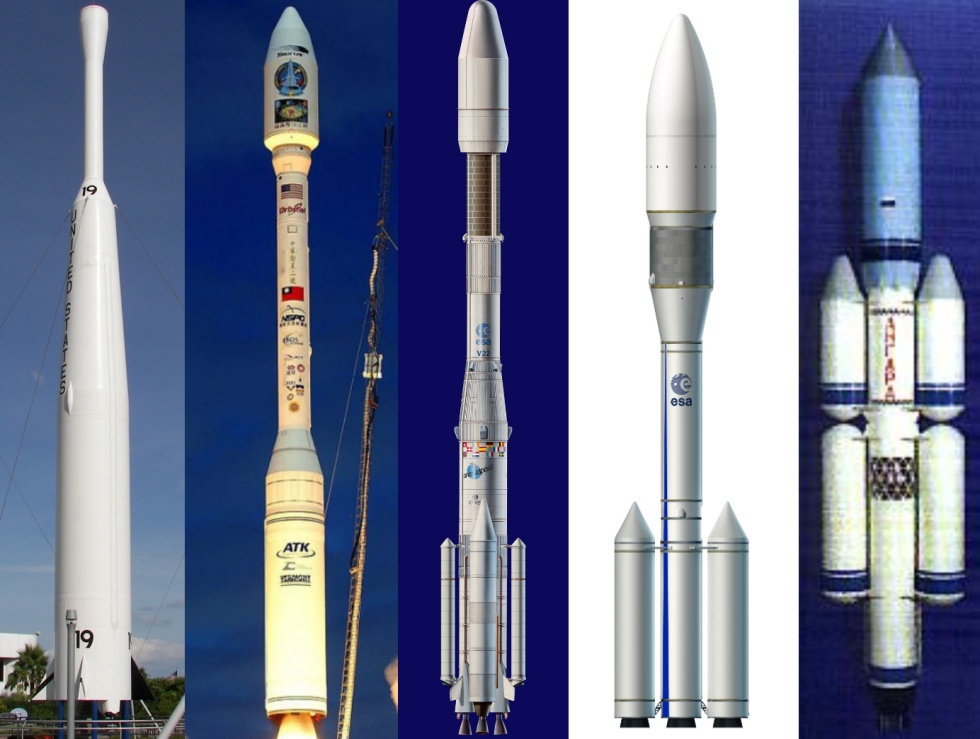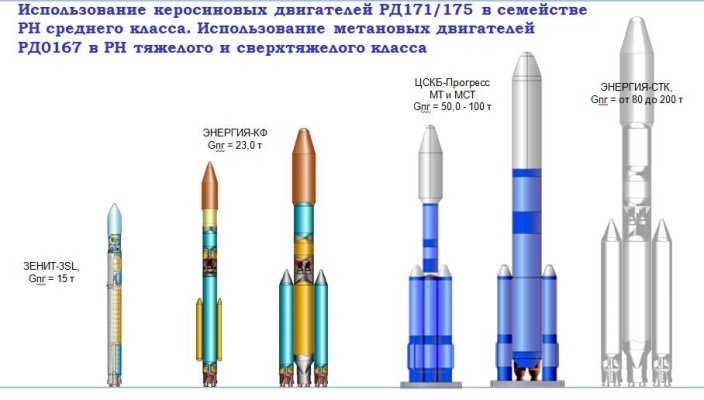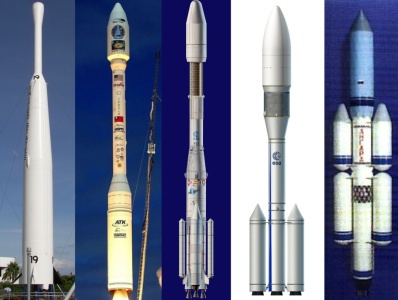Imperceptible complexity of rocket technology. Part 3: types of liquid fuels, geometrical dimensions, transportation

In the third part of the "Subtle difficulties of rocket technology," I would like to talk about the problems that are not covered in the first and second parts, which need to be solved. This article focuses on the development of various constraints that lead to engineering non-optimal solutions.
Types of liquid fuels
After the initial experiments, when rockets flew on ethyl alcohol, nitric acid, turpentine and other fun substances, three pairs of rocket fuel became the most common: oxygen / kerosene, oxygen / hydrogen, asymmetric dimethylhydrazine / nitrogen tetraxide. Naturally, each type of fuel has its pros and cons, which we now consider. However, first I want to give a definition of the specific impulse that has not sounded all this time:
Specific impulse is a measure of the effectiveness of rocket fuel. According to one definition, this is the number of seconds during which an engine can develop 1 Newton thrust, having spent 1 kg of fuel. The specific impulse is measured in seconds or meters per second. UI 1 with = 9.8066 m / s
Oxygen / kerosene . UI 358 c in a vacuum, averaged density (mixture density in the ratio for engine operation) 1.036 g / cm ^ 3. The most popular fuel, the most simple in work and the most mastered. There are two main disadvantages - not the highest API, and the fact that oxygen is stored in tanks in liquid form. Sometimes, they do not even put thermal insulation on launch vehicles, and when starting from it, the ice that has frozen from the air falls beautifully. But for overclocking blocks, insulation is needed and requires additional mass. Also, liquid oxygen cannot be stored for months for orbit corrections. There is a curious physical hack - supercooled oxygen, i.e. oxygen at a temperature below the boiling point. It is a little denser, so it will fit more into the same tank, and it does not boil so actively when refueling. A lot of modern launch vehicles are flying on this pair - Soyuz, Zenit, Atlas, Falcon.
Oxygen / hydrogen . UI 455 with in emptiness, the average density of 0.3155 g / cm ^ 3. The greatest UI, but there are serious flaws. Liquid hydrogen delivers far more problems than oxygen. First, due to the low density of the oxygen / hydrogen vapor tank will be 2-3 times higher than the tanks of other fuel pairs with the same diameter. Secondly, the tank must be made with thermal insulation, because otherwise liquid hydrogen will actively evaporate. Even with thermal insulation, it is necessary to drain the tank and feed it with liquid hydrogen almost until the start. Drainage of evaporated hydrogen must be removed, because its mixture with air is explosive. The overclocking unit with these components should work for several minutes, long-lived modifications of the blocks that lived for hours, were made in single copies and turned out to be much more expensive. Shuttles and Energia flew on this pair, Americans Delta, Europeans A-5 and H-IIs fly.
UDMH / AT . UI 344 with in the void, the average density of 1.185 g / cm ^ 3. AI is slightly lower than oxygen / kerosene, very high density, boils at above zero temperature, self-igniting when components are mixed, like a dream, not fuel. One problem, UDMH - a terrible poison. The highest toxicity class according to NFPA 704, mutagen, teratogen, carcinogen. AT is also not a gift, but it is lower in the hazard class, poisonous like chlorine, and plants grow well after it - nitrogenous fertilizer. The minor disadvantages of this fuel pair are the corrosion of materials (but this can be combated) and the higher cost than the oxygen / kerosene pair. On it fly "Proton", "Long march" of the Chinese and GSLV Indians. The “Titans” of the Americans and the “Arians” of Europeans flew, but in launch vehicles it will gradually disappear. The danger of spilling hundreds of tons of components during an accident and the need to deactivate the section of the fall of the spent stage makes it unpromising to use this pair in launch vehicles. But it is used in acceleration units and propulsion satellites, because it can be stored for a long time and without problems in flight.
Geometrical dimensions of the stage, transportation
In terms of geometry, the maximum volume at a fixed area is achieved for the ball. Both the aerodynamic drag and the full surface of the cylinder are proportional to the square of the radius, so the rockets would have to be rather low and wide. However, in reality, the rockets are very thin and high. The fact is that increasing the diameter increases the complexity of manufacturing and transporting the stage. I had a hypothesis that the measure of the complexity of working with a step is inversely proportional to the square of the radius. I collected data on missile launches over the past twenty years (many launches will give a statistical base, and not a very large time range will lead to an error due to technology changes) and plotted the number of launches depending on the largest step diameter (widest tank). Interestingly, the hypothesis was confirmed:

You can also recall the story of how the width of two ancient Roman horses led to the limitation of the payload of the Space Shuttle. This, of course, is a bike, and even the NASA standardization department has bothered to refute it , but the general principle is correct - the task of transportation poses big problems for the development of launch vehicles.
Calculations
I made a document in google docs. You can see the size of the step, depending on the desired characteristic speed, fuel and diameter. Hopefully, Google will allow you to copy the data into your document to play around with the parameters. The set parameters are set to something similar to the Delta-IV universal unit. Pay attention to a much higher than the real, characteristic speed. In reality, there is still a loss of air resistance, gravity, the engine gives less impetus to the Earth due to atmospheric pressure, etc.
The second sheet of the document contains data on missile launches over the past twenty years and the diameter of the largest tank, as well as a graph of the data collected.
Open document
')
How can anyone
The USA was lucky not only with the breadth. Their cosmodrome is located on the seashore, and it is not a problem to bring steps on a ship or barge:

On the left is a barge for transporting an external fuel tank “Space-Shuttle”, in the center is transportation from the pier to the vertical assembly building, on the right is a “Delta Mariner” transport carrying the “Delta-IV” and “Atlas-V” stages
Therefore, the Americans could carry the steps of the Saturn-V with a diameter of 10.1 m and external fuel tanks of eight-meter-diameter shuttle shutters.
For Europeans, the Kourou Cosmodrome is also located near the coast, which again makes it possible to use large steps - 5.4 m from the “Arian-5”:

Well, our situation is much more complicated. The first stage N-1 with a diameter of 17 meters was welded already in Baikonur, the central block of "Energia" was carried by plane. The diameter of the "Proton" is actually 4.1 m, the side tanks of the first stage are already attached when the rocket is assembled at Baikonur. And, according to rumors on the Internet, when transporting blocks of a rocket, it is necessary to block oncoming traffic by rail. Here it is - the secret enemy of the national cosmonautics - railway clearance:

Already on “Angara” cars with a diameter of 2.9 m, an oversize index is clearly visible - it is almost marginal in width (5 out of 6):
Railway transport for us is still the only available. Carry on the plane is expensive, and the size limit is present. New special aircraft will cost much more. It is very expensive to assemble on site - you need to build a new plant. It is also impossible to transport along rivers - special barges for rivers and ships will be needed for movement along the Northern Sea Route. Considering that now in Roskosmos there is some stir about the development of an extra-heavy rocket, it becomes very curious what geometry will be chosen there, and how will it be transported?
Layout
The times when money was poured into space a lot, and it was possible to build such an engineering-beautiful Saturn-V, alas. Now all over the world there is a fashion for “flying fences” from universal modules that should be comfortable and cheap:

From left to right: Delta IV, Atlas V, Falcon 9, Angara
When mass production such URM should be cheap. There is a curious movie, albeit a few of the future, because it uses friction welding, which has not yet been mastered:
By the way, compare with the previous video, the constructed workshop is quite recognizable. More on the shop and equipment can be found here and here .
Launch facilities
I was very interested in the question, what caused such a strange arrangement in the "Hangars" version of 1995?

No need to think that this scheme was made by amateurs or "enemies of the people." Imagine that the yard is the first half of the nineties. At Baikonur Razdrai, Kazakhstan, which has become independent, can arrange problems with the use of the spaceport. "Proton" must be replaced by something. But the state has no money for anything, and large-scale projects definitely will not work. And at the Plesetsk cosmodrome there is an almost unfinished launch for the Zenit. Zenit is launching nearly fourteen tons into orbit. If you make a new rocket in the dimension of "Zenith", hanging additional tanks, then the payload can be increased. So this strange construction appeared.
The same factor of a ready-made launch facility predicts a good future for the Soyuz-2.1v . Starts for the usual "Unions" are at Baikonur, Plesetsk, Kuru (but they are unlikely to be allowed in there - the competition is "Vega"), a start is being built at "Vostochny".
By the way, the idea of parallel arrangement of tanks was implemented in the Proton. At the first stage there is one oxidizer tank with a diameter of 4.1 m and six fuel tanks, which are equipped with engines. It turned out even elegantly - communications were brought to the bottom of the oxidizer tank, which made a separate cable mast unnecessary. And the first stage has become noticeably shorter, which is useful for reducing bending loads and simplifies work with the rocket as a whole. What is curious, they still don’t want to forget this idea - for example, a picture of some sketches from a report from November 2013:

the second rocket on the left - parallel tanks located on the first stage, the third on the left - side and central tanks for different components
Money
This restriction is actually spread over all the others, because any engineering solution has its price. For clarity, the ugly rockets on the KDPV for the most part have become so ugly due to the fact that already used blocks of different diameters were used, and an increase in the diameter of the satellites led to the need to create over-caliber fairings.

The first to the left is a rocket - “Thor - Able” On the already existing ballistic missile "Thor" they put the level "Able", which they made for the Avangard missile.
The second is “Taurus”. Under the steps of the Pegasus rocket of an air launch, they placed a stage with an ICBM “MX”
The third is “Ariane-4.” Unfortunately, I did not find my direct ancestors, from where she appeared so ugly - it is not clear.
The fourth - "Ariane-6." The transition to new solid fuel blocks, and the upper stage remains with the "Arian-5", so it has a larger diameter.
Fifth - "Angara" version of 1995. I already spoke about it.
PS Of the last four articles, two were actually written on your requests. I have a list of interesting topics on which articles can be written, and it is still far from exhausted, but I would like to know if there are any topics on which you would like to read a popular science article about astronautics? Offer your wishes in the comments, if they interest me, then I will put them in turn articles.
Source: https://habr.com/ru/post/211054/
All Articles